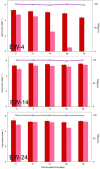Ralstonia solanacearum Facing Spread-Determining Climatic Temperatures, Sustained Starvation, and Naturally Induced Resuscitation of Viable but Non-Culturable Cells in Environmental Water
- PMID: 36557756
- PMCID: PMC9784099
- DOI: 10.3390/microorganisms10122503
Ralstonia solanacearum Facing Spread-Determining Climatic Temperatures, Sustained Starvation, and Naturally Induced Resuscitation of Viable but Non-Culturable Cells in Environmental Water
Abstract
Ralstonia solanacearum is a bacterial phytopathogen affecting staple crops, originally from tropical and subtropical areas, whose ability to survive in temperate environments is of concern under global warming. In this study, two R. solanacearum strains from either cold or warm habitats were stressed by simultaneous exposure to natural oligotrophy at low (4 °C), temperate (14 °C), or warm (24 °C) temperatures in environmental water. At 4 °C, the effect of temperature was higher than that of oligotrophy, since R. solanacearum went into a viable but non-culturable (VBNC) state, which proved to be dependent on water nutrient contents. Resuscitation was demonstrated in vitro and in planta. At 14 °C and 24 °C, the effect of oligotrophy was higher than that of temperature on R. solanacearum populations, displaying starvation-survival responses and morphological changes which were stronger at 24 °C. In tomato plants, starved, cold-induced VBNC, and/or resuscitated cells maintained virulence. The strains behaved similarly regardless of their cold or warm areas of origin. This work firstly describes the natural nutrient availability of environmental water favoring R. solanacearum survival, adaptations, and resuscitation in conditions that can be found in natural settings. These findings will contribute to anticipate the ability of R. solanacearum to spread, establish, and induce disease in new geographical and climatic areas.
Keywords: VBNC; bacterial wilt; environmental stress; global warming; pathogenicity.
Conflict of interest statement
The authors declare no conflict of interest. The funders had no role in the design of the study; in the collection, analyses, or interpretation of data; in the writing of the manuscript; or in the decision to publish the results.
Figures






Similar articles
-
Induction of the viable but nonculturable state of Ralstonia solanacearum by low temperature in the soil microcosm and its resuscitation by catalase.PLoS One. 2014 Oct 8;9(10):e109792. doi: 10.1371/journal.pone.0109792. eCollection 2014. PLoS One. 2014. PMID: 25296177 Free PMC article.
-
Survival strategies and pathogenicity of Ralstonia solanacearum phylotype II subjected to prolonged starvation in environmental water microcosms.Microbiology (Reading). 2008 Nov;154(Pt 11):3590-3598. doi: 10.1099/mic.0.2008/019448-0. Microbiology (Reading). 2008. PMID: 18957611
-
Interactions with hosts at cool temperatures, not cold tolerance, explain the unique epidemiology of Ralstonia solanacearum race 3 biovar 2.Phytopathology. 2009 Oct;99(10):1127-34. doi: 10.1094/PHYTO-99-10-1127. Phytopathology. 2009. PMID: 19740025
-
Effects of ecological factors on the survival and physiology of Ralstonia solanacearum bv. 2 in irrigation water.Can J Microbiol. 2001 Sep;47(9):842-54. doi: 10.1139/w01-084. Can J Microbiol. 2001. PMID: 11683466
-
Ralstonia solanacearum, a widespread bacterial plant pathogen in the post-genomic era.Mol Plant Pathol. 2013 Sep;14(7):651-62. doi: 10.1111/mpp.12038. Epub 2013 May 30. Mol Plant Pathol. 2013. PMID: 23718203 Free PMC article. Review.
Cited by
-
Key mechanisms of plant-Ralstonia solanacearum interaction in bacterial wilt pathogenesis.Front Microbiol. 2025 Jun 6;16:1521422. doi: 10.3389/fmicb.2025.1521422. eCollection 2025. Front Microbiol. 2025. PMID: 40547798 Free PMC article. Review.
-
Plant Pathogenic Microorganisms: State-of-the-Art Research in Spain.Microorganisms. 2023 Mar 22;11(3):816. doi: 10.3390/microorganisms11030816. Microorganisms. 2023. PMID: 36985389 Free PMC article.
-
Development of TaqMan Real-Time PCR Protocols for Simultaneous Detection and Quantification of the Bacterial Pathogen Ralstonia solanacearum and Their Specific Lytic Bacteriophages.Viruses. 2023 Mar 25;15(4):841. doi: 10.3390/v15040841. Viruses. 2023. PMID: 37112822 Free PMC article.
References
-
- Fegan M., Prior P. How Complex Is the “Ralstonia solanacearum Species Complex”? In: Allen C., Prior P., Hayward A.C., editors. Bacterial wilt Disease and the Ralstonia solanacearum Species Complex. APS Press; St. Paul, MN, USA: 2005. pp. 449–461.
-
- Safni I., Cleenwerck I., De Vos P., Fegan M., Sly L., Kappler U. Polyphasic taxonomic revision of the Ralstonia solanacearum species complex: Proposal to emend the descriptions of Ralstonia solanacearum and Ralstonia syzygii and reclassify current R. syzygii strains as Ralstonia syzygii subsp. syzygii subsp. nov., R. solanacearum phylotype IV strains as Ralstonia syzygii subsp. indonesiensis subsp. nov., banana blood disease bacterium strains as Ralstonia syzygii subsp. celebesensis subsp. nov. and R. solanacearum phylotype I and III strains as Ralstonia pseudosolanacearum sp. nov. Int. J. Syst. Evol. Microbiol. 2014;64:3087–3103. - PubMed
-
- Elphinstone J.G. The Current Bacterial Wilt Situation: A Global Overview. In: Allen C., Prior P., Hayward A.C., editors. Bacterial wilt Disease and the Ralstonia solanacearum Species Complex. APS Press; St. Paul, MN, USA: 2005. pp. 9–28.
Grants and funding
- QLK 3-CT-2000-01598/EU project
- project UV-INV-AE 112-66196/University of Valencia (UV)
- 00/Laboratory of Reference for Plant Pathogenic Bacteria of the Spanish Ministry of Agriculture (MAPA) at Instituto Valenciano de Investigaciones Agrarias (IVIA)
- 00/University of Valencia-Research Support to BACPLANT group GIUV2015-219.
LinkOut - more resources
Full Text Sources

